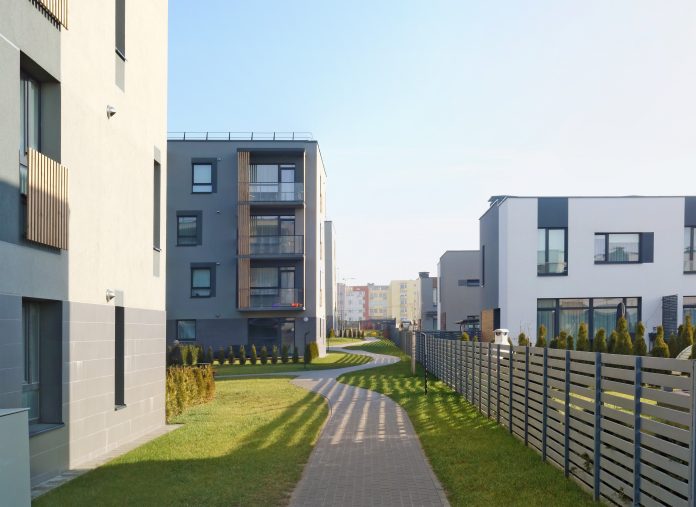In an exclusive interview with Gail Cook of Glen Dimplex Heating & Ventilation (GDHV) and Dr Stephen Finnegan sustainable architecture lecturer at the University of Liverpool, we discover how trends in modular housing and the heating and ventilation sector could address the social housing crisis
Research has revealed that England has a backlog of almost four million homes. 340,000 new homes need constructing each year until 2031 to meet demands.
Social housing makes up 17% of the overall housing market and is a low-cost alternative to homeownership for people who may not be able to access the private market.
With the UK facing its biggest housing shortfall on record, the rate at which homes need to be constructed is likely to soar. To ensure housing regulations are met, much like traditional builds, the market needs to consider more sustainable alternatives.
Modular homes are considered one potential way to deliver high-quality housing in a cost-effective and timely manner. One form of modular build is where factory-manufactured homes are built in sections and then assembled on-site, taking less time and labour to complete than traditional builds. They can vary from the fabric of the building to the internal piping and ductwork, meaning technologies such as ventilation systems and heat pumps can be easily connected on site.
In its upcoming eBook, GDHV explores the trends around social housing, modular builds and the future of the building industry. We spoke to eBook co-authors Dr Stephen Finnegan and Gail Cook, head of global marketing and communications at GDHV, to discover more.
What is it about modular construction that could change the way the industry delivers housing, and in particular social housing?
If we consider the government’s 2050 net-zero carbon plans, we need to create more sustainable, environmentally-friendly homes.
We need an extra 340,000 homes every year if we are to meet housing targets – this is where modular construction could have a massive role to play. Not only does it appear able to produce homes in the necessary volume, but it could also do so in line with sustainable, net-zero requirements.
What are the benefits of modular techniques for social housing?
When we build with modular in a prefabricated, factory setting, we can achieve consistent quality. The quality-control aspect is really important as we can have the same modular build coming out of the factory at a consistent and high-quality rate. It’s around 30-50% quicker to build a modular home than it is using traditional techniques and there’s much less impact on site due to the lesser time spent on-site. This method is an effective way of getting around skill shortages as there is a reduced need for labour on-site.
Waste is also radically reduced thanks to modular building.
Our solutions can meet the required standards in both traditional and modern methods of construction, helping homes to achieve really high energy efficiency standards required to reach the 2050 carbon goals.
At GDHV we’re developing products such as, our ‘Zeroth Energy System’ which can be built in a prefabricated cupboard, built within a frame and slotting into each apartment on-site. This provides low carbon heating, cooling and hot water services to residential spaces, reducing waste and meeting energy targets by a refrigerant-free low-temperature network and in-apartment heat pumps.
There’s a real drive for this need for a carbon-reduction solution which is the core of our business at the minute. The innovation we’re working on is really about decarbonising the electrical phase.
What is holding back the modular construction of social homes?
At the moment we’re seeing a really slow uptake of modular housing across the market. Only 1,000 of the 192,000 homes built last year modern methods of construction compared instead of traditional build techniques. Social housing providers prefer traditional construction techniques due to its familiarity.
The Governments Part L regulations are familiar to many; we have a readily available labour force and a vested interest in traditional build. However, if we continue down this route we’re simply not going to achieve the 2050 net-zero targets because these types of homes, especially in the social sector, are not able to achieve the environmental standards necessary. As a business, GDHV is committed to working towards a low carbon future. We are actively involved in Government discussions and has been heavily involved in the review of Part L and Part F regulations.
We have to think about fuel poverty. Those in the social housing sector need buildings of the future that are zero-energy – they need buildings that are run from renewable energy sources that cost less to operate. This is where modular construction has a key role to play as zero-energy buildings can be achieved with much more ease and affordability.
Can modular help us achieve sustainability?
At the University of Liverpool, we’ve been modelling modular homes for the last two years, alongside other types of energy efficient homes. Ironically, one of the problems we have is that these new types of homes are 100% electrically run. Electricity costs 3-4 times more than the cost of gas. Therefore, whatever type of zero energy home we build, whether it’s modular or traditional – if it’s run on 100% electric and we connect to the grid, they can still be costly homes to run. If we bring in renewables and the right technologies to heat and ventilate the properties we can get that energy bill lower.
If we look at battery storage, we can actually go beyond zero, where the homeowner can get paid from the grid.
Without renewables and technologies, the cost will still be relatively high.
At GDHV, we’re lobbying the government heavily around electrification we are currently working with energy suppliers and network operators to look at the tariffs that they have for our products. We’re investing in state-of-the-art controls, which allow you to manage individual radiators in each room.
The percentage of renewable energy usage has to continue to grow and the challenge within that is actually how do we store that energy? We must do this through battery power, storage heating and hot water tanks so we’re not wasting that renewable energy.
What impact will modular construction have on the HVAC industry?
We’re moving to a hotter climate and in the very near future (if not already) we’re all going to need more air conditioning. As the climate changes our reliance will be much heavier on air conditioning and in particular, we will need to retrofit modular homes with this system. Via a ‘fabric first’ approach you can have a building which is very airtight and can be regulated easily. We have to think about these homes over the next 30-40+ years and how the demand for energy via heating and cooling will change. This is where energy storage and advanced technologies can come into play to maintain a level of thermal comfort. Across Europe particularly we are going to see an increased need for cooling and ventilation, which hasn’t really been of great concern until now.
One of the challenges we have is space in buildings and utilising that space to provide for a heating system and a cooling system. GDHV’s Zeroth system is available for heating and cooling in apartments and uses the low-temperature network of water to water to heat and cool a home. In summer you can have comfort cooling, while in the winter you can have the heat. We are working on technology to solve the issues that we will face in the near future.
Social housing – will we need modular?
If we do build modular, we will have an airtight building which is really well temperature regulated. But, it’s not just about that, it’s about how it’s heated and cooled. We need to be in a position where we are able to achieve zero carbon homes and people in fuel poverty aren’t paying to heat or power their homes. Modular is on that track. There are a portion of homeowners across the UK who are already benefitting from this – they are already getting paid to heat their homes. These homeowners are net producers of energy – they sell to the network and the Distributed Network Operator (DNO) buys energy from them. There are only a handful of buildings that do this so far, but I don’t see why this can’t be the case for everyone in the future.
In our opinion, traditional builds could reach the zero carbon targets but it would be more difficult and expensive to achieve these goals than modular building.
The net-zero 2050 policy is currently just about how the building operates – how much heating, cooling and power we use within the building – it doesn’t include the embodied carbon impact. One of the new areas of research that Dr Stephen Finnegan has been heavily involved with is measuring and estimating the whole life cycle is of both modular and traditional homes. The Environmental Product Declaration (EPD) allows manufacturers of products to showcase their supply chain impact and allows you to see the impact of what making products like solar panels is. What’s the carbon impact of those? Are we simply shifting carbon from the operation to the embodied? The 2050 targets should include embodied carbon impacts to truly reach its potential.
Modular builders and housebuilders cannot tackle these issues on their own. At GDHV, we’re calling on Government to change some of the policies that support what we are doing – investing in R&D is crucial and messages to consumers need to be stronger, consumers need to be incentivised to get behind energy efficiency changes.
Dr Stephen Finnegan has worked as an energy and sustainability consultant for over 20 years and has recently moved back into academia. He is a lecturer in sustainable architecture at the University of Liverpool.
Gail Cook is the head of global marketing and communications at GDHV, where she is responsible for driving the sustainability message across the globe. GDHV wants to lead the way for a sustainable future.
Head of global marketing and communications
GDHV
Twitter: @GDHVOfficial
LinkedIn: Glen Dimplex Heating and Ventilation
Lecturer in sustainable architecture
Twitter: @LivUni


















